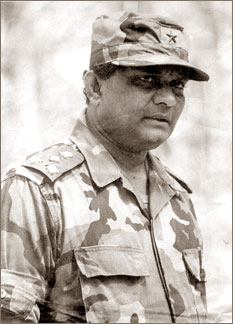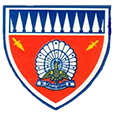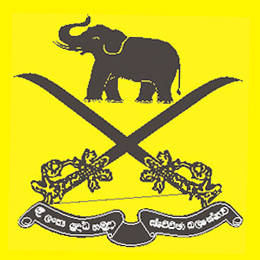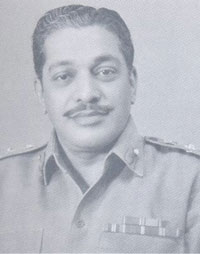
Major General Vanigamuni Indrajith Vijeyakumar Mendis Wimalaratne, RWP, RSP, VSV, USP was a senior Sri Lanka Army officer. One of the most distinguished field commanders in Sri Lanka, Wimalaratne raised the Gajaba Regiment, he commanded the 1st Brigade during the Vadamarachchi Operation, he commanded the Amphibious Task Force Commander during Operation Balavegaya and was the Commander Security Forces – Jaffna at the time of his death in a land mine explosion at Point Arali in the Kayts Island while making preparations to re-capture Jaffna.

The Sri Lanka Army is the oldest and largest of the Sri Lanka Armed Forces. Established as the Ceylon Army in 1949, it was renamed when Sri Lanka became a republic in 1972. In 2010, the Army had approximately 200,000 regular personnel, between 20,000 and 40,000 reserve (volunteer) personnel and 18,000 National Guardsmen and comprises 13 divisions, one air-mobile brigade, one commando brigade, one special forces brigade, one independent armored brigade, three mechanized infantry brigades and over 40 infantry brigades.

The Sri Lanka Armoured Corps (SLAC) provides the armour capability of the Sri Lanka Army, with vehicles such as the T-55AM2, and type 80/88 main battle tanks; the BMP infantry fighting vehicle; and the BTR-80, and WZ551 armoured personnel carriers. It comprises six regular armoured regiments, a volunteer regiment, and a regimental band. It has an independent Armoured Brigade and is headquartered at Rock House Army Camp, Colombo.

The Gajaba Regiment (GR) is an elite infantry regiment of the Sri Lankan Army. Formed on 14 October 1983 at the Saliyapura Camp in Anuradhapura, it is named after the famous Sinhalese King Gajabahu the First. It consists of 14 regular battalions and 6 volunteer battalions.

The Gemunu Watch (GW) ("King Dutugemunu's Own") is a infantry regiment of the Sri Lanka Army, formed with troops from the Ceylon Light Infantry and the Ceylon Sinha Regiment in 1962. It has been deployed in many major operations against the LTTE. It is made up of 14 regular units and 9 volunteer units. Headquartered at Kuruwita Army Camp, Ratnapura. It is named after one of the most famous Lankan Kings, King Dutugemunu.

The Sri Lanka Army Volunteer Force (SLAVF) is the active-duty volunteer reserve force of the Sri Lanka Army. The SLAVF is separate from the Regular Force which consists of personal who are professional soldiers and its Regular Reserve, which comprises personal who have a mobilization obligation following their service in the regular army. The SLAVF consists of the volunteer force and the volunteer reserve; administration and recruitment of reserve personal is carried out by the Volunteer Force Headquarters in Shalawa, Kosgama which is headed by the Commandant of the Volunteer Force. It has a current strength of about 55,000 personnel. The SLAVF was known as the Ceylon Volunteer Force from 1949 to 1972 and the Sri Lanka Volunteer Force from 1972 to 1985.

General Deshamanya Don Sepala Attygalle, was a Sri Lankan army general, civil servant and diplomat. The longest serving Commander of the Sri Lankan Army (1967–1977), he went on to serve as the Permanent secretary to the Ministry of Defence and Sri Lankan High Commissioner to the United Kingdom.
The Battle of Pooneryn, was a battle between the militant Liberation Tigers of Tamil Eelam and the Sri Lankan military during the Sri Lankan Civil War for control of the military base in Pooneryn in northern Sri Lanka from 11 November to 14 November 1993.

General Tissa Indraka Weeratunga, VSV was a Sri Lankan general. He was the former Commander of the Sri Lankan Army and the first General Officer Commanding (GOC) of the Joint Operations Headquarters (JOH), he was later Sri Lanka's High Commissioner to Canada.
Major General M.C. Mendaka. P. Samarasinghe, RWP, RSP, USP, ndc, psc, SLE was a Sri Lankan general and former Chief of Staff, Sri Lanka Army and also the former Commander Security Forces Headquarters - Jaffna; he was also the General Officer Commanding, 22 Division.
General Shavendra Silva, WWV, RWP, RSP, VSV, USP, ndc, psc, MPhil is a Sri Lanka Army general who is the current Chief of Defence Staff, the head of the Sri Lanka Armed Forces serving from 1 January 2020. He also served as the Commander of the Sri Lanka Army from 19 August 2019 to 31 May 2022. His other important appointments include, Chief of Staff of the army, Adjutant General and Director of Operations of the Army. During the Sri Lankan civil war he gained fame as the General Officer Commanding of the elite 58 Division. He had also served as the Deputy Permanent Representative to the United Nations Headquarters.
General Shantha H.S. Kottegoda, WWV, RWP, RSP, VSV, USP is a retired senior Sri Lanka Army general. He was the seventeenth commander of the Sri Lankan Army from 1 July 2004 – 5 December 2005. He had served as the Sri Lankan Ambassador to Brazil and Thailand. In April 2019, following the Easter Sunday bombings he was appointed as the permanent secretary to the Ministry of Defence.
Brigadier M. H. Gunaratne, VSV, psc, SLAC was a Sri Lankan military officer, former Commander Security Forces Headquarters - East, Commander, Task Force I and Task Force III and Commandant, Army Training Centre
General G. D. H. Kamal Gunaratne, WWV, RWP, RSP, USP is a retired Sri Lankan army general. He is the Secretary to the Ministry of Defence and the State Ministry of National Security and Disaster Management. A retired career officer of the Sri Lanka Army, Gunaratne had served as the former Commander Security Forces Headquarters - Wanni, General Officer Commanding (GOC), 53 Division and was a former Deputy Ambassador to Brazil. He was the GOC of the 53 Division which killed the LTTE leader Velupillai Prabhakaran at Nandikadal, Mullaitivu.

General L. D. E. Cecil Waidyaratne, VSV, USP was a Sri Lanka Army general. He was 12th Commander of the Sri Lankan Army and a former Sri Lankan Ambassador to Thailand.

The structure of the British Army is being reorganised to the Future Soldier structure. The Army is commanded by the Chief of the General Staff (CGS), with Army Headquarters which is located in Andover, Hampshire. Subordinate to that post, there is a Commander Field Army, and a personnel and UK operations command, Home Command.
The following is a hierarchical outline for the structure of the British Army in 1989. The most authoritative source for this type of information available is Ministry of Defence, Master Order of Battle, and United Kingdom Land Forces, HQ UKLF, UKLF ORBAT Review Action Plan, HQ UKLF, 1990.
Major General A. K. Sumedha Perera, WWV, RWP, RSP, USP is a retired Sri Lankan general. He is the Permanent Secretary to the Ministry of Mahaweli, Agriculture, Irrigation and Rural Development; and former Deputy Chief of Staff of the Sri Lanka Army.
Major General Jagath Gunawardena, RSP, VSV, USP was a Sri Lankan senior army general. He was the Chief of Staff of the Sri Lankan Army, having served as the Commandant of the Volunteer Force, Commander, Security Forces Headquarters – Wanni and Master General of Ordnance. He served as the Colonel Commandant of the Sri Lanka Engineers.
Lieutenant General H.L.V.M. Liyanage, widely known as Vikum Liyanage, is a Sri Lanka Army General. He is the current Commander of the Sri Lanka Army serving from 1 June 2022. Prior to become the army commander, he was the 59th Chief of Staff of the Army. On 1 June 2022, Liyanage assumed as the 24th Commander of Sri Lanka Army. Earlier, he served as the Commandant, Sri Lanka Army Volunteer Force as a Major General.









